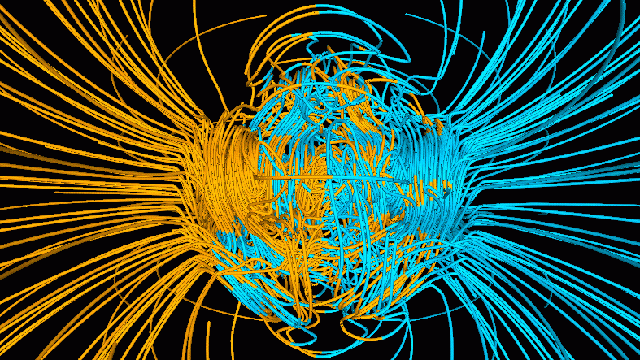
A computer simulation shows the Earth's magnetic field lines and two poles, with blue lines directed inward and yellow lines directed outward. (Gary A. Glatzmaier / UCSC)
The planet's northern magnetic pole is drifting slowly but steadily towards Russia -- and it's throwing off planes in Florida.
Tampa International Airport was forced to readjust its runways Thursday to account for the movement of the Earth's magnetic fields, information that pilots rely upon to navigate planes. Thanks to the fluctuations in the force, the airport has closed its primary runway until Jan. 13 to change taxiway signs to account for the shift, the Federal Aviation Administration said.
The poles are generated by movements within the Earth's inner and outer cores, though the exact process isn't exactly understood. They're also constantly in flux, moving a few degrees every year, but the changes are almost never of such a magnitude that runways require adjusting, said Paul Takemoto, a spokesman for the FAA.
The magnetic fields vary from place to place. Adjustments are needed now at airports in Tampa, but they aren't immediately required at all airports across the country.
So just how often is something like this necessary? "It happens so infrequently that they wouldn't venture a guess," Takemoto told FoxNews.com. "In fact, you're the first journalist to ever ask me about it."
Takemoto was quick to point out that the change, which also was required at Tampa's smaller Peter O. Knight airport, will have no effect on passenger safety.
"You want to be absolutely precise in your compass heading," he pointed out. "To make sure the precision is there that we need, you have to make these changes."
Kathleen Bergen, another spokeswoman for the FAA, explained that runway designations and charting rely upon geomagnetic information. "Aviation is charted using latitude and longitude and the magnetic poles," she told FoxNews.com.
The busiest runway at Tampa International will be re-designated 19R/1L on aviation charts. It had been 18R/36L, indicating its alignment along the 180-degree approach from the north and the 360-degree approach from the south, explained an article in the Tampa Tribune detailing the changes. Later this month, the airport's east parallel runway and the seldom used east-west runway will be closed to change signs reflecting their new designations as well.
"The Earth's poles are changing constantly, and when they change more than three degrees, that can affect runway numbering," Bergen said.
While rejiggering the runways is a very extreme event, the fields are constantly in flux and constantly being remapped, explained Lorne McKee, a scientist with the geomagnetism division of Natural Resources Canada.
"Since the fields change relatively slowly, they're marked out at 10 degree increments," he explained. The field has swung from approximately 10 degrees east in the late 16th century to 25 degrees west in the early 19th century -- before returning to a current value of about 3 degrees west.
It wasn't immediately clear when or even if changes would be required at other airports. And even the rate of change is inconsistent, McKee said, noting that it's changing much more quickly at the poles themselves.
Beyond just sliding around the planet, the magnetic north and south poles have been known to completely flip as well; these reversals, recorded in the magnetism of ancient rocks, are unpredictable. The last one was 780,000 years ago. Are we overdue for another? No one knows.
FoxNews.com's Jana Winter contributed to this report.




















